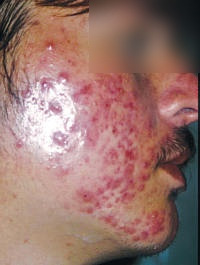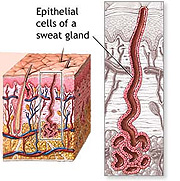 Clinical
note: Sebaceous glands become much more active after puberty and
can become affected by acne vulgaris, in which blocked ducts or hair
follicles produce small white lesions (comedones) caused by build-up
of sebum and dead cells. The disease is normally self-limiting, but
comedones can become sites of bacterial infections. Sometimes there
is marked scaring left in the wake of the inflammation. Clinical
note: Sebaceous glands become much more active after puberty and
can become affected by acne vulgaris, in which blocked ducts or hair
follicles produce small white lesions (comedones) caused by build-up
of sebum and dead cells. The disease is normally self-limiting, but
comedones can become sites of bacterial infections. Sometimes there
is marked scaring left in the wake of the inflammation.
On slides
identify the
- Secretory portions and
darker-staining ducts of merocrine (“eccrine”) sweat glands.
- Myoepithelial cells surrounding
the secretory units (better shown on
slide 89).
- In the ducts, note the unusual
stratified cuboidal epithelium lining the ducts
 and the lack of myoepithelial cells. and the lack of myoepithelial cells.
Examine the micrograph of apocrine
sweat glands and look for these structures
- Compare the lumen size and overall
histological appearance of apocrine sweat glands to the more
common merocrine/eccrine sweat glands.
What is the functional
significance of having apocrine sweat glands in skin of only certain
body areas?
Examine the structure of nails and
their association with other parts of a digit as shown on the demo
slide.
How does the structure of a
nail and nail bed compare with that of a hair follicle?
More on skin
appendages. |